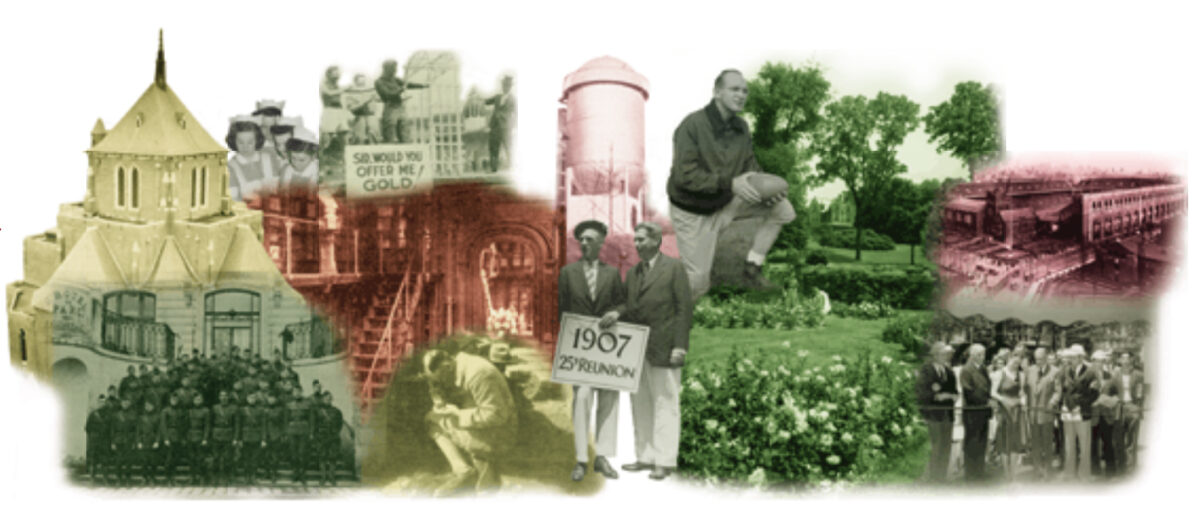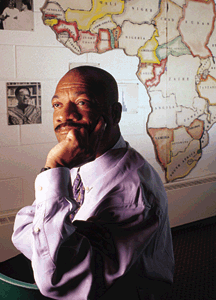Boom, bust, and the University’s bicentennial.
After World War I ends in November 1918, the Gazette publishes a running tally of alumni killed in the fighting and stories of service overseas such as the “Remarkable Record of Base Hospital No. 20,” whose doctors, nurses, and enlisted men, recruited almost entirely from the University, cared for 9,000 patients (losing only 65) in less than seven months in France.
With the signing of the Armistice, students flock back to the University, reversing a steep wartime decline in registration. In 1919-20, enrollment surpasses 10,000 for the first time.


1919 | General Leonard Wood speaks at the first post-war Commencement. Wood, extolled as the “prophet of preparedness,” will later be named “executive head” of the University, but take several leaves of absence to serve as governor general of the Philippines and ultimately resign without ever having served in College Hall.
1920 | The School of Fine Arts is founded.
1921 | The Wharton School establishes a graduate division.
1922 | Commencement is held on campus for the first time, in two sections, at Weightman Hall. Combined British Museum-University Museum excavations at Ur begin.

1923 | Old Franklin Field stands are torn down, and the first tier of the present stadium is built. The Gazette advertises “A New Panoramic View of Franklin Field Stadium In Its Completed Form as Seen from Top of Surgical Pavilion,” for sale at $2 per copy in sepia or black and white prints. Provost Josiah Penniman C1890 Gr1895 Hon’22 is appointed to be Penn’s president as well.
1924 | The Moore School of Electrical Engineering opens. The University celebrates Washington’s birthday for the 99th year in succession. Bennett Hall is under construction, and the Christian Association announces plans for its new building at 36th and Locust streets.
1925 | The May 1 Gazette announces the kickoff of the University’s first fundraising campaign, with a goal of raising $42 million by 194o. The Henry C. Lea Library is presented to the University. A second level is added to Franklin Field, bringing seating capacity to 8o,ooo. The General Alumni Society assumes responsibility for publishing the Gazette.
1926 | Henry Woolman C1896 offers 178 acres of farmland near Valley Forge to the University, touching off a decade of debate in the pages of the Gazette over creating a new undergraduate campus at the site.
1929 | On May 9, 1,2oo attend the dedication of Irvine Auditorium. In October, days before the stock market crash that will usher in the Great Depression, the Gazette runs a long article on conditions in Europe that begins, “An American observer … could not fail to be impressed with a revival of optimism.”

1930 | After students burn the “two most unpopular instructors” in effigy, a “rowbottom” develops in which Philadelphia police run amok, shooting their way into fraternities and boarding houses to beat and arrest students indiscriminately. The University broadcasts a “comprehensive series of radio programmes” daily over station WCAU, Philadelphia, offering faculty lectures and musical performances. Thomas Sovereign Gates W1893 L1896 Hon’31 Gr’46 is named president of the University, its first full-time chief executive. Penniman continues as provost.
1931 | The “Gates Plan” reorganizes provisions for student health, physical education, and intercollegiate athletics, replacing the alumni-dominated University Council on Athletics and banning special treatment for football players. The Wharton School marks its 5oth anniversary. Horace Mather Lippincott C1897 becomes editor of the Gazette, replacing George Brian Hurff C’24, who was appointed in 1929.
1932 | The Morris Arboretum is bequeathed to the University.
1933 | The College of Liberal Arts for Women is founded.
1935 | After more than a century, the University announces the cessation of Washington’s birthday celebrations. The School of Nursing is established.
1936 | The Alumni Award of Merit is instituted. The Daily Pennsylvanian celebrates its 50th anniversary. Four dramatic societies merge to form Penn Players.
1937 | The Fels Institute of State and Local Government is established. The Gazette frequency goes from biweekly to 10 times yearly.
1938 | George Munger’s first season as football coach. The team’s record is 3-2-3.

1939 | The Gazette unveils a new cover design, and an “atom smasher” is installed at the University. Dr. George W. McClelland C’12 Gr’16 Hon’31 is named provost. World War II begins.
1940 | The University celebrates its bicentennial with five days of events in September 1940, including an academic symposium, a river pageant and water carnival, and speeches by President Franklin Delano Roosevelt and former President Herbert Hoover.




